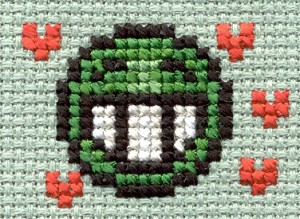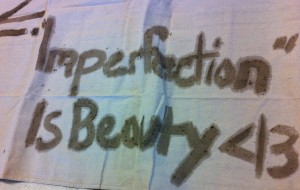
As part of my research I spend a lot of time preparing and conducting science lessons with 8th graders. Today they got to learn how to make moss graffiti. After a quick botany lesson they were allowed to paint whatever they wanted onto a large canvas drop cloth. What surprised me the most was the students’ overwhelming desire to simply write their names. If they didn’t write their names, they usually wrote a short phrase. Out of about 80 students, there were only a handful of drawings. Almost every student decided to write text. Some of that text, strangely enough, took the form of emoticons. Why would anyone choose to draw an emoticon?
This is interesting for two reasons. First, it flys in the face of popular belief that kids are allergic to writing of any kind. Texting, Facebook, and Twitter may not demand proper grammar, but it does get kids (even at very young ages) to write. Schools could benefit from capturing this desire to write, if they can effectively route it through language art curriculums. Schools should install browser plugins and other software that –instead of the usual spell check– runs kids through grammar and spelling lessons before the text is released to Facebook.
While learning old grammar and spelling rules are important, educators should also be on the lookout for new forms of expression. Emoticons are the product of linear typing styles. There is, seemingly, no reason to hand-write an emoticon. And yet…
Drawing emoticons is also interesting because I simply do not know how to read it out loud.While I didn’t have the chance to ask, I do not think the whole message is meant to be read, “Imperfection Is Beauty broken heart”. Rather, the emoticon implies an inflection and tone meant to be read, not spoken. Is this a new literary device, or is there a pre-internet analog? I welcome your suggestions in the comments.
This post is adapted from an original post at the RPI 3Helix site.
You can follow David Banks on twitter: @da_banks


Comments 6
sally — June 14, 2012
:-)
Brigid Keely — June 15, 2012
I'm 33 and have been online and using emoticons since the late 90s, and when I hand write letters to people I include emoticons and sometimes emoji, as well as "text" or "leet" speak like LOL. To me, they are in part an extension of older letter shorthands and quips, like writing a large D on the left with "liver/letter/sooner/better" stacked immediately to the right of it (Deliver De (the) letter De (the) sooner De (the) better) or SWAK (Sealed With a Kiss) or XOXOXO or whatever. They communicate an emotion and sense of belonging as much as anything else.
Kate — June 15, 2012
This makes me think of illustrations to stories, which supply the tone to the text. Oddly enough, it also makes me think of illuminated manuscripts, since the illuminations also gave comments on the text. In other words, I think this desire to add a graphic to text is really rather old.
However, the graphics themselves have changed to be influenced by digital. Basically, we do most of our writing online where we can't actually draw a broken heart, so we just do when writing what we do online. Just as you said.
Lluis — June 15, 2012
I find your quick note very inspiring. I suggest that you read this essay published on the New York Times' Opinionator blog. It's titled "Taling with your fingers" and suggests that e-mails and texts are forms of "fingered speech", and that "e-mail and texting are new way of talking."
http://opinionator.blogs.nytimes.com/2012/04/23/talking-with-your-fingers/
It would be interesting to examine whether emoticons are also a type of fingered speech...
Callan — June 18, 2012
The presence of an emoticon in a sentence written like this could be to convey a tone. I think of how commonplace it is to see a Facebook status like, I don't know, "<3 waiting in line at the DMV 4lyfe" and read in all of the requisite sarcasm that heart emoticon and that stylized epithet can convey. But on the other hand, as you mentioned, it also might be a signal that the phrase is meant to be read silently (as if seen on some distant screen, rather than on physical, AFK paper). There's something private about it, something that gives off the distinct impression of being a tiny snippet of a late-night IMversation, brought out all the more by how silly and awkward it would sound if it were read out loud (just as so many other elements of those chat conversations would)...
Cyborgology — June 20, 2012
[...] week I wrote a (brief!) note on emoticons, in which I noticed that even when children aren’t texting they choose to use emoticons to [...]